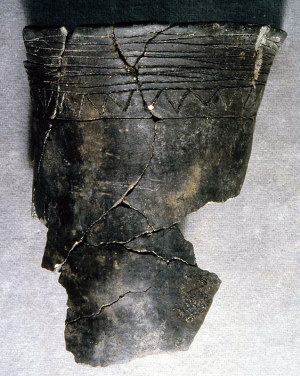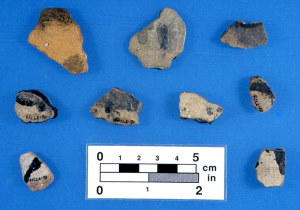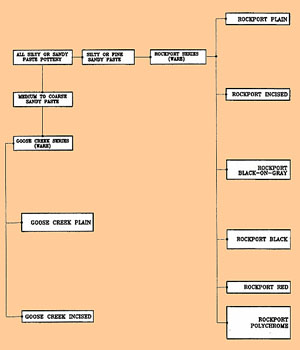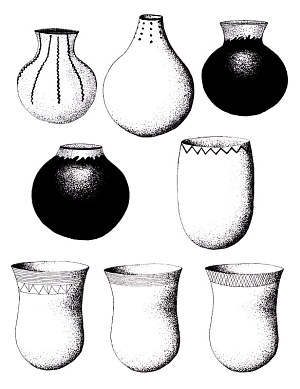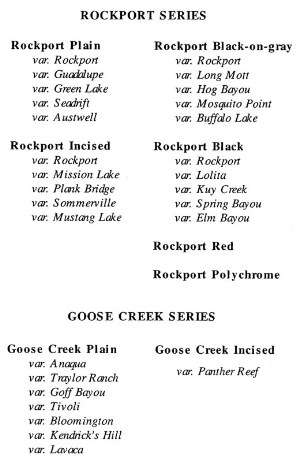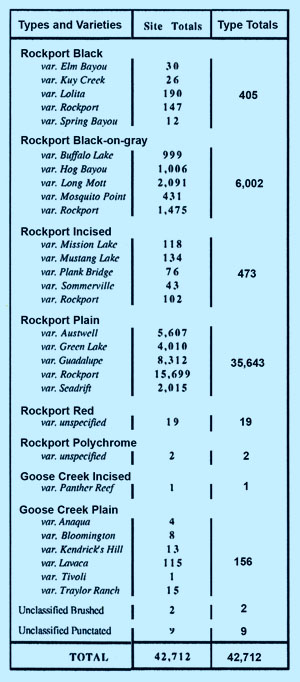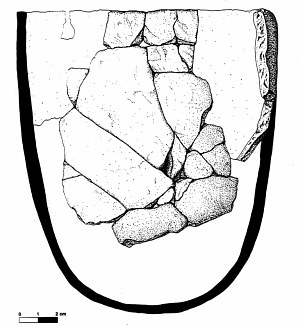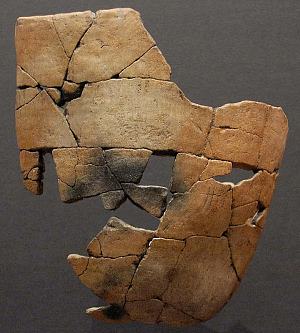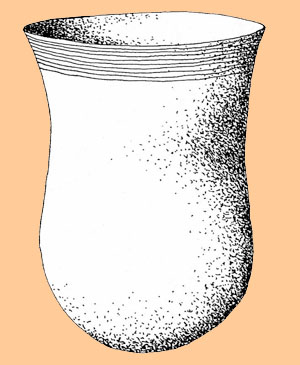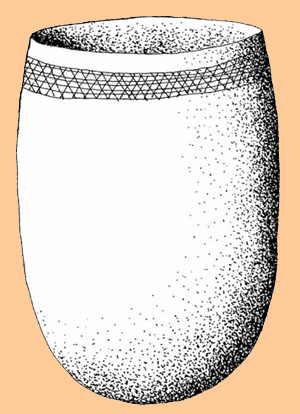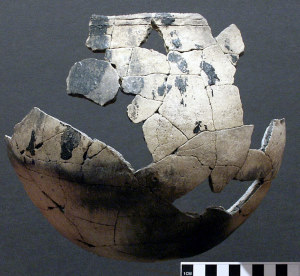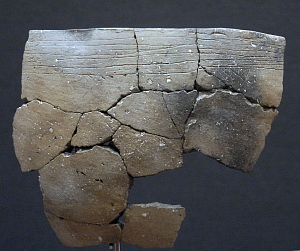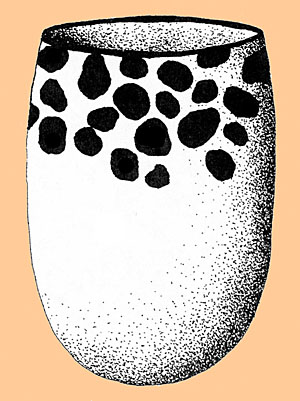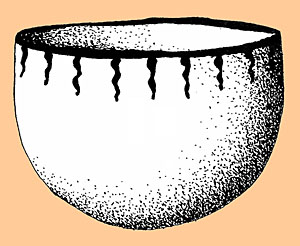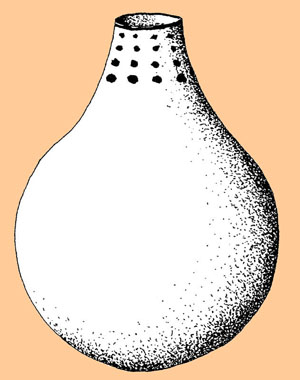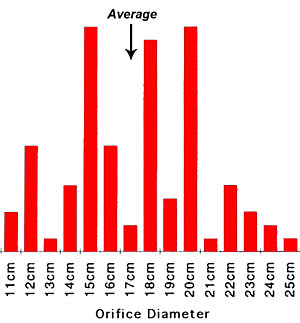Rockport Pottery
|
The 1992 excavations at the Guadalupe Bay site resulted in the largest collection of aboriginal ceramics ever analyzed from a site on the central Texas coast – 42,712 individual sherds. Included in the analysis were all sherds recovered as field specimens, all sherds captured in the 1/4-in screens, and all sherds collected from the site’s surface. In fact, it may be the largest sample of ceramics analyzed from a single site anywhere in Texas outside the Caddoan culture area. Below, following a succinct overview, we review what has been learned about the site’s pottery in some detail. OverviewThe vast majority of the Guadalupe Bay ceramic assemblage is classified as various types of plain and decorated Rockport pottery, the earthenware style characteristic of the central Texas coast. There were no intact or reconstructable pottery vessels, except for a sizable section of one beaker. The bulk of the 42,712 sherds were undecorated plainware, although many of these sherds were likely fragments of the lower parts of incised and painted vessels. Vessel forms were dominated by simple beakers and jars with rounded or pointed bases, the majority of which mainly functioned as cooking and storage containers. All Rockport pottery was made using the coil method and fired at relatively low temperatures in open fires. The characteristically well-consolidated, silty or fine sandy paste of Rockport pottery makes for somewhat more durable pottery than the sandy Goose Creek ware found mainly on the upper Texas coast. The exterior surfaces of the site’s Rockport pottery were typically well-smoothed and, in the case of the painted pottery, often covered with a fine gray slip. Three previously defined Rockport pottery types were recognized: Rockport Plain (35,643 sherds), Rockport Black-on-gray (6002), and Rockport Incised (473). The extensive collection from Guadalupe Bay allowed for the recognition of three new types: Rockport Black (405 sherds), Rockport Red (19), and Rockport Polychrome (2). Also present was a very small amount (.4 percent) of Goose Creek pottery. All of the 157 sherds of Goose Creek pottery were Goose Creek Plain except for a single sherd of Goose Creek Incised. The large collection was classified using the type-variety system, a sorting system developed in the American Southwest, Mesoamerica, and the Lower Mississippi Valley. This system was used during the Guadalupe Bay analysis as a first step for sorting central Texas coastal ceramics into meaningful types and varieties useful for studying changes through time and across the region. The 6,901 painted and incised sherds also allowed the definition of 22 decorative motifs, showing that many obvious and subtle variations on the previously recognized decorative themes exist within Rockport pottery. These variations can be studied in the accompanying Decorative Motif Gallery. Some 153 sherds were large enough to determine vessel form. Beakers (often called straight-sided jars) far and away outnumbered all other forms combined representing over 60 percent of all vessels. Jars with everted (flaring) rims and simple bowls were fairly common, with smaller numbers of shallow bowls and bottles, as well as a single globular bowl. Taken together, jars and beakers accounted for 81.7 percent of the assemblage, while all bowls equaled 15.7 percent. The jars and beakers are thought to represent cooking and storage vessels, while the bowls were likely serving vessels, and the bottles were meant to hold liquid. The relative infrequency of bottles seems a bit unexpected, given the dearth of potable water often encountered along the coast – perhaps the water containers were made of pitch-lined basketry, gourds or other perishable containers. There was a clear association between painted vessels and bowl and bottle forms, showing that painted vessels represent a “fine ware” category of ceramics that were used primarily as serving containers. Bottles and shallow bowls also had thinner walls, supporting the idea that these were not ordinary vessels. In contrast to this, plain and incised vessels were thicker, commonly had fire-blackened exterior surfaces, and probably were employed mainly as everyday cooking and storage containers. The rather detailed summary of the technical analysis that follows will give interested readers insight into how such a large collection of pottery can be studied. Others may just want to peruse the images. Truly serious students of the subject will want to consult the 120-page ceramics chapter in the Guadalupe Bay technical report. See Chapter 7, Aboriginal Ceramics Ceramic AnalysisAnalysis of this collection was an extremely laborious and time-consuming endeavor designed to investigate both chronological and functional questions regarding the Guadalupe Bay ceramic collection. The primary method used to examine site chronology was the type-variety system of ceramic classification, as devised by Sylvia Duay and Richard Weinstein during their analysis of material from the 1989 testing project along the barge canal and by Duay and others during a similar testing project along the lower Lavaca River. Analyses of decorative motifs, rim form, and vessel form also were employed. Functional questions were addressed through the use of numerous attribute analyses, including such factors as vessel shape, orifice diameter, and vessel wall thickness. Analytical techniques employed for this study began with the identification of the various paste characteristics of individual sherds. Identification of a sherd’s paste is the critical first step required in this analysis system, and is necessary before that sherd can be assigned to a ware series, and, subsequently, to a specific type and then to a variety within that series. Paste IdentificationThe presence or absence of sand grains in the paste of a sherd, plus the size of the sand grains, were key sorting criteria based on previous research on ceramics of the central Texas coast. These were recognized as the basic matrix of the sherd, and were referred to as “primary inclusions” in the paste. In order to determine the size of the grains, each sherd was broken along one edge and carefully observed under a 10x hand lens, or low-power binocular microscope. The grains then were measured with the aid of a Wentworth size scale, and the sherd’s paste classified according to three size categories: (1) silty paste (grains <1/16 mm in diameter), (2)very fine (1/16 to 1/8 mm) to fine (1/8 to 1/4 mm) sandy paste, and (3) medium sandy paste (1/4 to 1/2 mm). No coarse-size sand grains were observed. Almost all sherds fell within the very fine to fine grain-size category, thereby placing the vast majority of the collection into the Rockport series. Only a few sherds had a paste with medium-size grains, and these were assigned to the Goose Creek series. In addition, there were other significant differences between Goose Creek and Rockport wares other than grain size. All Rockport sherds, for instance, exhibited a very compact, well-consolidated paste that appeared harder than almost all Goose Creek examples. Goose Creek ware, on the other hand, had a much higher ratio of sand in the paste, making it softer and more friable than Rockport ware. Because of the high sand content, Goose Creek ceramics also had a much sandier surface texture, at times approaching that of fine sandstone. Often, loose particles of sand became dislodged from a Goose Creek sherd if one rubbed it with one’s fingers. When taken together, all of these factors (quantity and size of sand grains, compactness and hardness of the paste, and general surface finish) provided a relatively clear break between Rockport and Goose Creek wares. Once the primary paste characteristics of a sherd were identified, and that sherd was assigned to either the Rockport or Goose Creek series, then it became necessary to identify the so-called “secondary inclusions” within that sherd’s paste. Previous research recognized secondary inclusions as potentially significant tempering agents that could provide important chronological and cultural information. Since it was assumed that the silt and sand within the paste of a sherd represented elements occurring naturally in the clays of the area, then any additional material might represent culturally introduced temper. Initially, a drop of a 10-percent solution of hydrochloric acid was applied to a fresh break along each sherd’s outer edge and any reaction to the acid was observed to determine the nature of the secondary inclusions. This method proved time consuming and was abandoned in favor of briefly submersing the entire sherd in the acid solution (still after a piece had been broken off). Total immersion of the sherd offered a quick and efficient way of identifying visible inclusions, plus finding and identifying minute inclusions that were not visible at first. Overall, nine paste categories, or subcategories, were identified based on the presence or absence of secondary inclusions: (1) no visible inclusions, (2) caliche, (3) bone, (4) shell, (5) caliche and bone, (6) caliche and shell, (7) caliche, bone, and shell, (8) shell and bone, and (9) unidentified white inclusions (inclusions that did not react to acid). Generally, bone inclusions ranged from a single speck to a profuse amount. The bone was usually white to gray in color, although occasional shades of brown were noted. It was seldom black. Most often, the white bone inclusions had been pulverized, causing angular particles that were easily visible on the sherd surface and along the break edges. Sherds containing shell were the easiest to visually identify, as the size of the shell particles generally were the largest of all inclusions observed. The amount of shell in the paste exhibited the same broad range as that noted for the bone; that is, from a single speck to a relatively large quantity. Shell particles usually were white in color, but shades of gray also were common. The amount of hard caliche present in the sherds from Guadalupe Bay was somewhat higher than the other secondary inclusions. There never were instances where only one or two pieces of caliche were present. Rather, hard caliche ranged from several particles to profuse amounts, and was always white in color. Since hard caliche totally dissolved in the acid solution, careful observation of the sherd prior to submersion was necessary. It was found, however, that if a sherd was dipped in the acid solution and then removed immediately, the dissolving hard caliche could be observed while it disappeared. Soft caliche inclusions were relatively rare at Guadalupe Bay. When present, they usually appeared as round nodules that initially could be mistaken for pieces of grog temper (broken-up pieces of pottery). Once subjected to the acid, however, then a very high reaction occurred. Soft caliche ranged in color from white to pale gray, but it often became a bit darker when placed in the acid solution. Decoration and Surface AlterationFollowing identification of the ware of a specific sherd, plus the recognition of any secondary inclusions that might be present, that sherd was searched for any evidence of intentional decoration and/or surface alteration. Basically, seven main decorative groups were recognized over the course of the analysis: (1)incised, (2) black painted on gray or white slip, (3) black painted without a slip, (4) punctated, (5) brushed, (6) red filmed, and (7) polychrome painted. These are thought to represent intentional decorative techniques that would have produced recognizable design patterns on the surface of a vessel. Three of the decorative groups (incising, black painting on a gray or white slip, and black painting on an unslipped surface) made up the vast majority of all decorated ceramics recovered at Guadalupe Bay. Recognition of different decorative designs (or motifs) led to the development of a second major method of classifying the pottery from Guadalupe Bay, the “motif” method described below. Rim/Lip ModificationIn addition to sorting by paste and surface alteration, sherds were separated into rim and body categories. Rim sherds were further examined for their shape and any decorative treatments specific to that part of the vessel. Several types of rims were recognized at Guadalupe Bay. These included (1) rounded, (2) flat, (3)pointed, and (4) beveled. Three decorative treatments were recognized for vessel lips at Guadalupe Bay: (1) lip banding, (2)lip incising, and (3) lip notching. Lip banding was the most common treatment in the collection and consisted of a painted asphaltum band around the lip of the vessel. This band usually fell into the wide category (>4 mm) and occurred simultaneously on the interior, exterior, and top of the lip. Sometimes the band was a bit more narrow, and/or only occurred on one or two portions of the lip (i.e., the top and exterior, or the top only). Lip incising was represented by short, multiple lines placed either on the top of flat lips or on the upper few millimeters of pointed lips. Lines on top of flat lips either were oriented perpendicular to the long axis of the rim or were slanted across the top of the lip. Lines on pointed lips were oriented vertically and generally extended up and over the lip, occurring on both the exterior and interior surfaces of the rim. Lip notching occurred either as shallow V-shaped or square depressions impressed into the top of the rim. Notching varied according to the space between the individual notches, and the width of the notches themselves. These are equivalent to what other researchers have identified as “crenelated.” No scalloped rims were present in the collection. Vessel Form and SizeWhen possible, rim sherds of sufficient size were used to assess vessel form to allow inferences to be made about aboriginal activities at Guadalupe Bay. Several classes were recognized: (1) beakers, (2) jars, (3) beakers or jars, (4) bottles, (5) simple bowls, (6), shallow bowls, and (7) globular bowls. Rim sherds also were used to estimate the orifice diameter of vessels if the sherd was large enough or curved enough to allow for a reasonable measurement to be obtained. Sherds were measured by placing them on a board marked by concentric circles spaced one centimeter apart. The overwhelming majority of the sherds, however, were very small and their orifice diameters could not be measured. Lastly, the wall thickness of every sherd was recorded to the nearest millimeter in an effort to obtain potential chronological and functional information. Measurements were taken with a set of calipers. In the past, several investigators have taken great pains to measure the wall thickness of each sherd in their respective collections. Although the extreme range varied slightly from collection to collection, the average thickness remained relatively consistent. As summarized by Suhm and Jelks in the 1962 Handbook of Texas Archeology, Goose Creek ware ranges from 2 to 10 mm in thickness with an average of 6mm. Rockport ware, on the other hand, is markedly thinner, ranging between 1.5 and 7 mm in thickness with an average of 3mm. The average thickness for all Guadalupe Bay sherds is 4.8 mm. Ceramic ClassificationArcheologist Michelle Hutchins classified the aboriginal ceramics from Guadalupe Bay according to the type-variety system of ceramic classification. This system has the flexibility of pinpointing subtle differences in paste and decorative techniques that could be utilized in the recognition of fine-scale chronological units and/or culturally meaningful ceramic assemblages. The system builds upon the work of earlier investigators, but provides a set of sorting criteria and ceramic nomenclature intended to allow for replicability during future analyses and a simplified system of communication. The type-variety analysis is primarily a descriptive system that has great utility in organizing and discussing the local prehistoric pottery. Its main virtue derives from the fine-scale chronological and/or regional control that is theoretically obtainable through its use. It does not, however, lend itself to many functional interpretations, other than a few cases where specific types or varieties may be associated with a specialized purpose, such as those types that only are represented by serving plates or bowls. The type-variety system can, nevertheless, be used in conjunction with other systems, such as those that identify vessel form and size, thereby providing both chronological/spatial and functional information Joe Ben Wheat and his colleagues first developed the type-variety system in 1958 for use in the southwestern United States. That same year Philip Phillips modified the system for use in the Southeast, and in 1970 employed it as the backbone of his research in the lower Yazoo Basin of Mississippi. It has since been used on a regular basis by archeologists working in the Lower Mississippi Valley and adjacent areas. Lawrence Aten first applied the type-variety system to his study of pottery from the upper Texas coast in 1979. But it was not until the Victoria Barge Canal work by Duay and Weinstein that a type-variety analytical approach was been employed along the central Texas coast. The system employed for the Guadalupe Bay ceramics is, of course, only a first step in sorting central coastal ceramics into meaningful types and varieties. It is expected that subsequent analyses of large collections, particularly those from well-dated stratified and single-component contexts will refine or alter these varieties, in some cases eliminating or combining one or more of them into more useful categories. Nevertheless, it is hoped that the use of the type-variety system will continue, and analysis of the ceramics of the region will become an important key in studying the Late Prehistoric period through time and across the region. Goose Creek PotteryThe Goose Creek ceramic series is characteristic of the upper Texas coast and was first described and defined in the early 1950s, beginning with the work of Jo Ben Wheat in the Addicks Reservoir basin. Many studies of this pottery have been undertaken over the last half-century, including the notable work of Lawrence Aten. Characteristically, Goose Creek pottery has a relatively high quantity of fine to coarse sand in a clay matrix. Aten and most other researchers believe that the high sand content simply reflects the likelihood that the aboriginal potters were utilizing naturally sandy clays, and not adding sand as a tempering agent. A few researchers, such as David Kelley, have suggested that particularly sandy examples of Goose Creek pottery may reflect the intentional addition of more sand to the paste. Whatever the case, the relatively high sand content is one of the key attributes used to sort Goose Creek ware from Rockport. Furthermore, the sandiest sherds often have the texture of fine sandpaper, and have poorly smoothed and uneven surfaces. Goose Creek ware typically contains poorly sorted sand grains, usually fine to medium in size, in a clay matrix. Because of the excessive quantity of sand in relation to the amount of clay, the paste often is extremely friable or crumbly. All of these attributes help identify Goose Creek ware and make it possible to sort it from Rockport ware in cases where the two series overlap geographically. In their 1992 report on the 1989 site-testing program along the Victoria Barge Canal, Duay and Weinstein set up local varieties of Goose Creek types along the same lines employed for Rockport types. Thus, the presence or absence of secondary inclusions within the paste of Goose Creek ceramics became the key to variety identification. This seemed only logical for sites along the upper part of the central Texas coast, where the Rockport and Goose Creek ceramic traditions appear to merge geographically (roughly, from San Antonio Bay to the Brazos Delta area). In addition to the secondary inclusions, the criteria for defining varieties of Goose Creek ware in central coast collections includes the presence of asphaltum coating, similar to that observed in some Rockport ware. This coating should not be confused with actual asphaltum paint. Instead it is the result of the use of asphaltum for waterproofing and crack mending. This makes sense when considering Goose Creek ceramics found along the central Texas coast. The strong local tradition of asphaltum use on Rockport pottery almost certainly carried over onto vessels with Goose Creek paste. Based on all of the above factors, two ceramic types, Goose Creek Plain and Goose Creek Incised, along with their constituent varieties, were identified at Guadalupe Bay. Rockport PotteryCeramics of the Rockport series have long been recognized at sites on the central and south Texas coasts. Prior to the Guadalupe Bay study, three types of Rockport pottery had been recognized: Rockport Plain, Rockport Incised, and Rockport Black-on-gray. The extensive collection from Guadalupe Bay allowed for the recognition of three new types: Rockport Black, Rockport Red, and Rockport Polychrome. Robert Ricklis has observed that the well-consolidated, silty or fine sandy paste characteristic of Rockport pottery is visually indistinguishable from the clay matrix from found in natural clays associated with the Beaumont Formation. He inferred that most of the material gathered to produce Rockport ceramics came from this Pleistocene-age geological formation, a formation that covers most of the coastal plain of Texas. Generally, the clay matrix of Rockport ware either contains only silt-size particles or a combination of silt and very fine fine sand (all particles <1/4 mm). Most vessels were fashioned from this clay matrix without the addition of any temper, the naturally occurring silt and sand serving as the only tempering agents. At other times, however, particles of bone, shell, or caliche were added, presumably as intentional tempering material. The addition (or lack) of these “secondary inclusions” provides the basis for identifying specific varieties under the present classification scheme. The bulk of Guadalupe Bay pottery with evidence of decoration falls into two broad categories: intentionally painted decoration (including Rockport Black-on-gray and Rockport Black), and incised decoration (Rockport and Goose Creek Incised). Two other minor categories, overall red filming (Rockport Red) and polychrome painting (Rockport Polychrome), were recognized. These, however, were not further characterized as they either lacked variation in decorative design or were very few in number. The remaining decorated sherds initially were separated by type and variety, and then each was given an alpha-numeric code that described the specific decoration present, termed a "design element” to better define recurring patterns. Once all excavated sherds were sorted by design element, it was possible to recognize recurring decorative patterns or motifs that form the highest order of decorative intent on the part of the aboriginal potters at Guadalupe Bay. Such motifs consisted of single design elements if the motif was relatively simple, or multiple design elements if it was slightly more complicated. At present, there are eight motifs recognized for Rockport Incised, seven motifs for Rockport Black, and seven motifs for Rockport Black-on-gray. The accompanying Decorative Motifs Gallery illustrates these 22 motif patterns and provides discussions of each. Chronological Implications of the Guadalupe Bay Ceramic DataAll of the detailed analyses of the aboriginal ceramics recovered at Guadalupe Bay would be relatively meaningless if they did not contribute to a better understanding of the chronological tendencies of the different types and varieties and decorative motifs. Unfortunately, there does not appear to be a great amount of difference in the vertical distribution of most of the ceramic types and varieties at Guadalupe Bay. This undoubtedly is a reflection of the disturbed nature of Stratum 2 and the relatively short time span involved in the deposition of most of the identifiable Rockport midden deposits (Stratum 2 in all blocks and Strata 3 and 5 in Block 3). Nevertheless, a few trends were noted. Most decorated types and varieties have their greatest showings in the deeper deposits, suggesting a trend towards the use of more plainwares in the later portion of the occupation. Rockport Red is the lone exception as far as decorated types are concerned, as it follows the plainware trend and has its greatest showing in the uppermost portion of Stratum 2. This may suggest that the type is very late in the overall Rockport sequence. Also, plain sherds with bone and shell in their pastes, and/or a combination of these and other materials, have slightly higher percentages in the deeper, and presumably somewhat earlier, Rockport levels. While only 157 out of the site’s 42,712 sherds (0.4 percent) were classified as members of the Goose Creek Series, a few patterns still were noticeable. Perhaps most striking was the complete lack of any Goose Creek ceramics in Stratum 1. Coupled with the strong showing of Goose Creek ware in AU 7 (2.8 percent), it seems likely that Goose Creek ceramics were most common during the earliest Rockport occupation at Guadalupe Bay. This makes sense, since author Weinstein suggested in 1992 that Goose Creek wares represent the earliest ceramics found along the central Texas coast. Interestingly, the Goose Creek varieties with the greatest percentages in the deeper deposits are Kendrick’s Hill and Traylor Ranch, both with bone inclusions in their pastes. This reinforces the idea that relatively high percentages of sherds with bone in their pastes may signal a slightly earlier RockportII subphase occupation. Turning to the decorative motifs, it was hoped that examination by analysis unit might help identify meaningful chronological trends. Unfortunately, few patterns were apparent among the Rockport Incised motifs. Tentatively, however, three motifs (“Ayres Point,” “Bendewald Point,” and “Foster Point”) occurred only in the lower portions of Stratum 2 or the underlying Stratum 3 Rangia midden in Block 3. Although the sample size for each of these motifs is relatively small, these motifs may represent early Rockport phase designs worthy of future chronological consideration. Similarly, few clear-cut chronological trends among the different Rockport Black motifs were apparent. Nevertheless, one tentative pattern was observed. The most common motif, “Carancahua Bay,” had its greatest showing in the upper levels of the site, suggesting that this decoration may have become more popular towards the latter portion of the Rockport phase. The distribution Rockport Black-on-gray motifs was somewhat similar to that of the various Rockport Black motifs, a not unexpected circumstance considering the likeness of the two types. “Steamboat Island” occurred in slightly greater numbers in the upper deposits, tentatively suggesting the motif increased in popularity through time. This mirrors the findings of the Rockport Black, “Carancahua Bay" motif. Rockport Ceramic TechnologyDuring the course of the ceramic analysis, a few additional observations were made regarding the technology employed in ceramic production at Guadalupe Bay. First, it became clear that the vessels had been created by the coiling method. In fact, one fired ceramic coil was recovered from the upper part of Stratum 2 (AU 3) in Block 3 at Guadalupe Bay. It had paste equivalent to the Seadrift variety of Rockport Plain, indicating that it probably was to be used in the manufacture of a Rockport ware vessel. Clay coils have been found at several other sites along the central Texas coast, showing that Rockport pottery was made by the coiling method, the method used by the vast majority of aboriginal potters throughout North America. Second, no obvious basal fragments, such as a flat-surfaced sherd or a “corner” sherd, were found among the almost 43,000 sherds examined. This strongly indicates that all vessels either had rounded or pointed bottoms, fragments of which would be curved just like all other body sherds. Even those vessels identified as shallow bowls must have had round bottoms. This fits the findings of previous researchers in the region, who have highlighted this trait as one of the key factors separating Rockport ceramics from those of other areas, particularly locations farther up the coast around Galveston Bay and on into Louisiana. Third, although sherd color was not systematically examined during the current study, several color tendencies were observed during the analysis and these led to additional research on sherds of the Rockport series. Small percentages of all five varieties of Rockport Black-on-gray, one sherd of Rockport Black, var. Elm Bayou, and several sherds of Rockport Plain, vars. Austwell, Green Lake, Guadalupe, and Seadrift, contained a very light, almost white, paste that was uniformly distributed throughout the interior of each sherd. The Rockport Black-on-gray sherds also exhibited a white outer slip, rather than the gray slip typical of that type. Initially, it was thought that sherds exhibiting this white paste had been manufactured from a different clay source than the majority of the sherds in the collection, and that they might provide information on trade or the range of travel of the occupants of the site. It also was thought that the white slip appearing on the sherds of Rockport Black-on-gray might have resulted from use of the same clay source as an element of the surface finish. In order to verify these assumptions, four sherds were submitted to Dr. R. E. Ferrell, Jr., of the Department of Geology and Geophysics at Louisiana State University (LSU) for X-ray diffraction analysis. Two of the sherds (Rockport Black-on-gray, var. Buffalo Lake) contained the white paste, while the other two (Rockport Plain, var. Rockport) exhibited typical dark gray to black paste. Basically, the x-ray diffraction indicated that the same clay source was used to manufacture all four sherds. Quartz made up the greatest percent, by weight, of the minerals comprising each sherd’s paste, followed by feldspars and illite (mica). Importantly, calcite was found only in the white-paste samples, almost certainly indicating that caliche (most probably of the “soft” variety) had been added to the clay to produce the white color. This also suggests that caliche was utilized in the white slip on the Rockport Black-on-gray specimens. Rather than indicating trade or travel, sherds with white paste appear to be from vessels that were manufactured for a special purpose, possibly as fine-ware serving bowls and/or plates. Sherds with white paste were present in all analysis units associated with the Rockport occupation at Guadalupe Bay, although they clearly were more prevalent in the Block 3 excavations. This suggested that the block had sampled an area that may have served as the locus for special feasts and/or social gatherings that utilized fine-ware serving vessels. Finally, 13 sherds with a highly contorted paste were recovered from the 1-by-1-m sample unit at N80W130. Although these may be nothing more than the aberrant work of a single potter who did not properly wedge the clay prior to vessel manufacture, the paste had an “early” look to it, and was somewhat reminiscent of Tchefuncte pottery from the Louisiana coast and Galveston Bay areas. While there is no question that these sherds are part of the Rockport series, their contorted nature may indicate an early effort at pottery manufacture similar to that of the Tchefuncte series. As such, these sherds might represent a very brief and potentially early Rockport occupation at Guadalupe Bay. The majority of these sherds appear to be related to the deepest ceramic-bearing strata in that sample unit, suggesting that an early occupation may be present but masked by the overwhelming numbers of typical Rockport ware also present. Vessel FormOne hundred and fifty-three rim sherds were large enough to determine vessel form, and these fell into seven main categories: beaker, jar, beaker or jar, bottle (or olla), simple bowl, shallow bowl, and globular bowl. Sherds with straight sides that lacked evidence of an outflaring (everted) or inflaring (inverted) rim were identified as beakers, while sherds with everted rims were identified as jars. These latter specimens usually showed evidence of a slightly constricted neck area that then flared outwards towards the rim. Simple bowls, shallow bowls, and globular bowls were sorted by the degree of rim closure. Shallow bowls were wide-mouth vessels with flaring sides; some extreme examples of which might have been classified as plates if enough of the vessel was present. Simple bowls also included wide-mouth vessels, but exhibited sides that were less flared than those of shallow bowls. Globular bowls had a constricted shape with inverted rims and relatively narrow mouths. Such vessels lacked any evidence of a neck, however, precluding their classification as bottles. Beakers far and away outnumbered all other forms combined (n=97), representing 63.4 percent of all vessels. The jar category, the next most common form, included 18 rims (11.8 percent) and this was followed in frequency by 15 rims from simple bowls (9.8 percent). Ten sherds came from either jars or beakers (6.5 percent), but were too small for proper identification, while eight sherds (5.2percent) were from shallow bowls and four (2.6 percent) were from bottles. Lastly, one sherd (0.7 percent) came from a globular bowl. Taken together, all jars and beakers (n=125) accounted for 81.7 percent of the assemblage, while all bowls (n=24) equaled 15.7 percent. It was found that certain vessel forms could be associated with different types and varieties. Beakers were associated with all types, with the greatest quantity (40.2 percent) associated with Rockport Plain. Rockport Black-on-gray (26.8 percent) and Rockport Incised (24.7 percent) followed in decreasing amounts. Only small percentages of the beakers were associated with Rockport Black (7.2 percent) and Rockport Red (1.0 percent). A slightly different pattern pertained to jars, with Rockport Incised (44.4 percent), Rockport Plain (16.7 percent), and Rockport Black-on-gray (also 22.2), making up the majority. In this instance, though, Rockport Black (16.6 percent) also made up a modest percentage of the total. Bottles and bowls exhibited a significantly different pattern, with Rockport Black-on-gray vessels providing the highest percentages for each vessel form. There was no mistaking the association of painted vessels with bottles and bowls. This association has also been recognized by other researchers, and suggests quite strongly that painted vessels represent a “fine ware” category of ceramics that were used primarily as serving containers. In contrast to this, plain and incised vessels probably were employed mainly as cooking or storage containers. The association of vessel forms and decorative motifs also was examined in an effort to find potentially meaningful relationships and to locate support for the assumptions expressed above. Although the sample was relatively small, amounting to only 65 sherds, a few observations were possible. First, all incised motifs occurred only on beakers or jars, thus supporting the cooking and/or storage function for the majority of these vessels. The painted motifs, on the other hand, occurred on all vessel forms, particularly the two black-banded motifs, “Carancahua Bay” and “Steamboat Island.” This supports the notion that painted vessels fulfilled several roles, including that of serving vessels. Vessel SizeAs noted, vessel size was determined by measuring the orifice diameter of those rim sherds or joined rim sherds large enough to provide reasonable data. One partial vessel and 116 individual sherds were large enough to supply useful orifice measurements. Generally, all beakers and jars (including vessels that could not be sorted as either beakers or jars) had orifice diameters that averaged between 17.3 and 17.6 cm, with a range between 8 and 28 cm. As to be expected, bottles had much smaller openings, averaging 5.0 cm, although the overall bottle sample (n=2) is exceedingly small. Again as to be expected, simple bowls and shallow bowls had the greatest orifice diameters, averaging 20.8 and 20.9 cm, respectively. This is logical, as bowls most likely represent wide-mouth serving containers. As with vessel form, the size of a vessel has been used in the past to determine its probable function. Generally, large, wide-mouth jars, with orifices between 40 and 50 cm in diameter, usually were identified as storage containers, while jars with smaller mouths were recognized as cooking vessels. Although no vessels with orifices greater than 30 cm were recovered at Guadalupe Bay, it still was felt that an examination of the size distributions could prove useful. By graphically plotting the size data as a histogram, it was hoped that a more recognizable distribution pattern might emerge. As can be seen in the accompanying chart, a unimodal pattern was present, indicating that jars and beakers were produced in one broad size class with orifice diameters generally ranging from about 12 to 20 cm. Thus, they most likely served one function, that of cooking vessels. Support for this assumption comes from the one partially reconstructed jar of Mustang Lake with the “Bendewald Point motif.” That vessel contains spots of charred food residue on its outer surface below the decorative field indicating that it was, indeed, used for cooking. Interestingly, the Guadalupe Bay orifice data agree quite well with that presented recently by Ricklis in his 2000 study of aboriginal pottery from Missions Espíritu Santo and Rosario. These sites had vessels with diameters generally ranging between 15 and 19 cm. When these data were compared to that for vessels from a small, short-term campsite, the Oak Mott site (16 AS92), Ricklis found that the camp had much smaller vessels with orifice diameters ranging between 10 and 14 cm. Thus, he suggested that large sites with semi-permanent or permanent occupations (Group I sites) probably had larger vessels that would have been difficult to carry, while smaller, short-term hunting or foraging sites (GroupII sites) had smaller vessels that were easier to transport. By inference, then, it can be argued that the Rockport occupations at Guadalupe Bay were of the semi-permanent or sedentary type, more akin to Group I sites. Vessel Thickness Almost every sherd from Guadalupe Bay was measured for thickness. Generally, individual sherds ranged in thickness between 2mm (for one of the bottle rims) to 8 mm (for one of the beakers and two of the simple bowls). The vast majority of all vessel sherds fell within the 4- to 6-mm range, with an average for all sherds of 4.8 mm. Beaker sherds measured between 3 and 8 mm, with an average of 4.8 mm, while jars ranged between 3 and 6 mm, with an average of 4.6 mm. Sherds classed as beakers or jars were most similar to jars, ranging between 4 and 6 mm, with an average of 4.6 mm. Simple bowls were the thickest of all vessels, averaging 5.1 mm, with a range of between 3 and 8 mm, while bottles were the thinnest, averaging 4 mm, although one sherd was 7 mm thick. Shallow bowls also had a rather restricted range, between 3 and 6mm, with a relatively thin average of 4.3 mm. The one globular bowl rim measured 4 mm thick. Overall, these figures suggest that bottles and shallow bowls were the thinnest vessels produced at Guadalupe Bay, followed by jars, and beakers or jars. Beakers were slightly thicker, while simple bowls were the thickest of all. Of course the total range of averages for each vessel category is not particularly great (only from 4 to 5.1 mm), and probably indicates a relatively uniform manufacturing process that would appear to represent a well-developed ceramic technology. It also is of interest to note the minor, though perhaps important, difference between the thicknesses noted for painted, incised, and plain vessels. For instance, all painted vessels, whether beakers, jars, or bowls, consistently produced relatively thin sherds, while incised and plain vessels yielded somewhat thicker sherds. Given all of the above, it would appear that vessel decoration (or the lack thereof) went hand in hand with vessel function, and this association is reflected in vessel thickness. This is in keeping with the notion discussed previously that many, if not most, of the painted vessels were relatively thin, fine-ware items used primarily as serving containers, while the plain and incised vessels were somewhat thicker and served mostly as cooking or, perhaps, storage vessels. |
|
